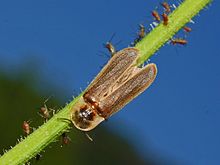
Back Grosser Leuchtkäfer ALS Lampyris noctiluca AN لامبريس نوكتيلوكا ARZ Lampyris noctiluca Catalan Lampyris noctiluca CEB Světluška větší Czech Sankthansorm Danish Großer Leuchtkäfer German Lampyris noctiluca Spanish Jaanimardikas Estonian
| Lampyris noctiluca | |
|---|---|

| |
| Male | |
| Scientific classification | |
| Domain: | Eukaryota |
| Kingdom: | Animalia |
| Phylum: | Arthropoda |
| Class: | Insecta |
| Order: | Coleoptera |
| Family: | Lampyridae |
| Subfamily: | Lampyrinae |
| Tribe: | Lampyrini |
| Genus: | Lampyris |
| Species: | L. noctiluca
|
| Binomial name | |
| Lampyris noctiluca | |
| Synonyms | |
|
Cantharis noctiluca Linnaeus, 1767 | |
Lampyris noctiluca,[2] the common glow-worm of Europe (see also "glowworm"), is the type species of beetle in the genus Lampyris and the family Lampyridae.
Lampyris noctiluca presents a conspicuous sexual dimorphism. The males are winged, with brown elytra, a clearer pronotum and a large brown spot in the middle, while females are larviform, wings are missing and they are often twice the size of the males (up to 25 millimetres or 1 inch in length).
These beetles use their bioluminescence to attract mates. The adult females are mostly famed for their glow, although all stages of their life cycle are capable of glowing.
In Britain, this species is fairly common compared to its cousin Phosphaenus hemipterus – the lesser glow worm – which is very rare.[citation needed]
The Lampyris noctiluca, commonly referred to as a glow worm, belongs to the Lampyridae family, which is Greek for "shining ones," and includes species known as fireflies or lightning bugs. Contrary to its name, it is not worm-like, but a beetle. These beetles are typically the most active at night and spend their day under debris, or in the ground. The larvae are also nocturnal and rarely seen — only coming out when the conditions are right in the months of April through October. The adult stage is much shorter than the larvae stage but they are much easier to spot then as they glow for a few hours and only stop glowing after mating.
- ^ Macadam, C., De Cock, R. & Henriques, S. (2024). "Lampyris noctiluca". IUCN Red List of Threatened Species. 2024: e.T216125791A216918599. Retrieved 15 July 2024.
{{cite journal}}: CS1 maint: multiple names: authors list (link) - ^ Linnaeus C (1758) Systema Naturae per regna tria naturæ, secundum classes, ordines, genera, species, cum characteribus, differentiis, synonymis, locis, Tomus I. Editio decima, reformata. Holmiæ: impensis direct. Laurentii Salvii. i–ii, 1–824 pp doi:10.5962/bhl.title.542: 400
© MMXXIII Rich X Search. We shall prevail. All rights reserved. Rich X Search
